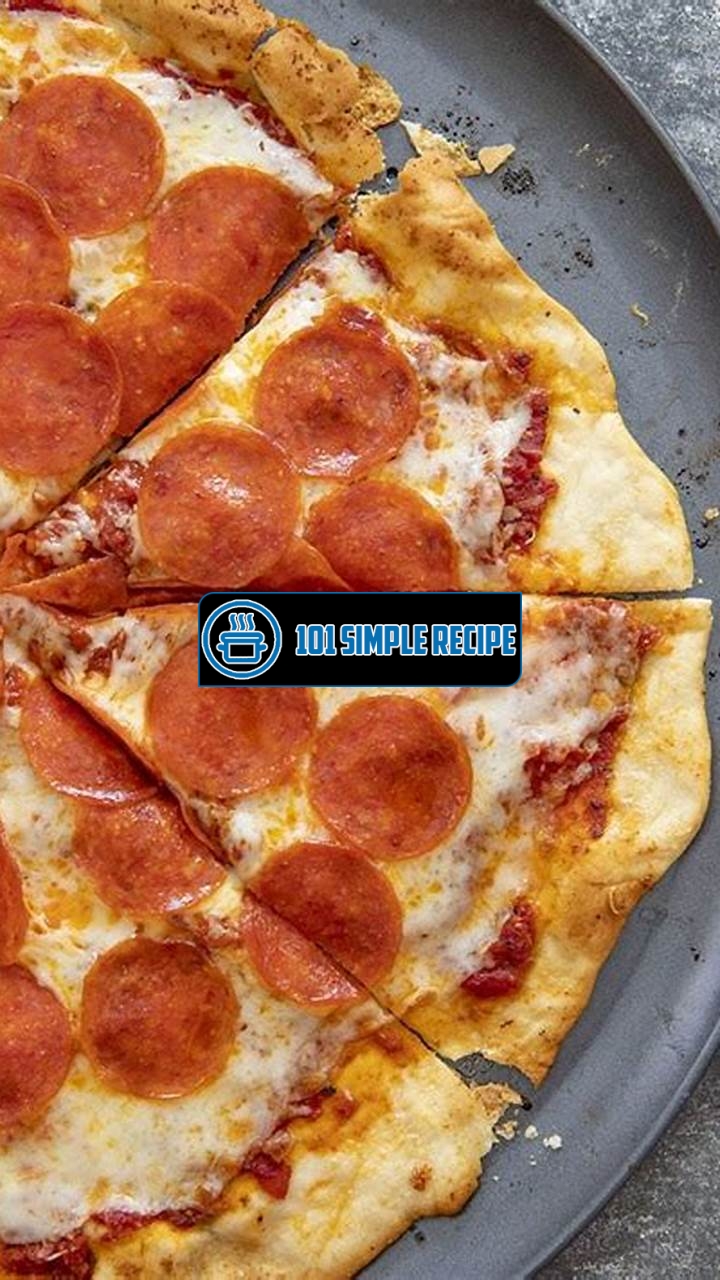If you’re a pizza lover and want to take your homemade pizza game to the next level, mastering the art of making easy thin crust pizza dough is a must! Thin crust pizzas have a crispy, delicate texture that perfectly complements a variety of toppings. By following a few simple steps, you can create a delicious thin crust that will rival your favorite pizzeria. In this article, we will guide you through the process of making thin crust pizza dough from scratch, ensuring that you achieve the perfect balance of flavors and textures. So grab your apron and get ready to impress your taste buds with a homemade thin crust pizza that is both easy and delicious!

Understanding Thin Crust Pizza Dough
Thin crust pizza dough has gained immense popularity among pizza enthusiasts due to its unique characteristics that set it apart from other types of pizza crust. This style of dough is known for its thin consistency and crisp texture, making it a favorite choice for those who prefer a lighter and less doughy pizza.
What Makes Thin Crust Pizza Dough Different?
Thin crust pizza dough stands out for its thinness, as the name suggests. Unlike thick or deep-dish crusts, this type of dough is rolled out thinly to create a delicate and crispy base for the pizza. The thinness allows the toppings to shine and keeps the focus on the flavors and textures.
Another distinctive feature of thin crust pizza dough is its ability to cook quickly. Due to its thin nature, the dough requires less time in the oven, resulting in a faster cooking process. This makes thin crust pizza an excellent choice for those who are short on time but still crave a delicious homemade pizza.
Advantages of Thin Crust Pizza Dough
There are several advantages to using thin crust pizza dough for your homemade creations.
- Lighter and Crispier: Thin crust pizza dough creates a lighter and crispier base compared to thicker crusts. This allows the flavors of the toppings to shine and provides a satisfying crunch with every bite.
- Versatile Toppings: The thinness of the crust allows for a wide range of toppings. From classic cheese and tomato to gourmet combinations, thin crust pizza dough serves as a canvas for any creative pizza masterpiece you desire.
- Healthier Option: If you’re watching your calorie intake or following a low-carb diet, thin crust pizza is an excellent choice. The reduced amount of dough means fewer carbohydrates and calories, making it a healthier alternative to thicker crusts.
Choosing the Right Flour for Thin Crust Pizza Dough
The choice of flour plays a crucial role in achieving the perfect thin crust pizza dough. Opting for the right type of flour helps create the desired texture and flavor. Here are a few popular flour options for thin crust pizza dough:
- All-Purpose Flour: This is a versatile option that produces a tender and crisp crust. It is ideal for those who prefer a balance between a crispy texture and slight chewiness.
- Bread Flour: With a higher protein content, bread flour creates a chewier crust. This type of flour is suitable for those who enjoy a more substantial bite in their thin crust pizza.
- Italian Tipo 00 Flour: This finely ground flour, commonly used in Italian pizza-making, yields an ultra-thin and delicate crust. It results in an incredibly light and crisp texture.
Remember, the choice of flour depends on your desired pizza crust texture and personal preference. It’s always a good idea to experiment with different flours to find the one that suits your taste.
Mastering the art of making easy thin crust pizza dough allows you to create delectable pizzas with a crispy and light base. Whether you prefer classic toppings or like to get creative in the kitchen, thin crust pizza dough provides the perfect foundation for your culinary creations.
Essential Ingredients for Easy Thin Crust Pizza Dough
Creating a delicious and easy thin crust pizza dough at home requires a few key ingredients. In order to achieve the perfect texture and taste, it is important to understand the role of each ingredient and how they interact with one another. Let’s explore the essential ingredients needed to master the art of making easy thin crust pizza dough.
Flour: The Foundation of Pizza Dough
Flour serves as the foundation of pizza dough, providing the structure and texture. When selecting flour for your thin crust pizza dough, opt for a high-protein variety such as bread flour or Tipo 00 flour. These types of flour contain more gluten, which helps create a chewy and elastic dough.
Pro Tip: To make your thin crust pizza dough extra crispy, you can also use a combination of bread flour and semolina flour.
Yeast: Creating a Light and Airy Texture
Yeast is a crucial ingredient in pizza dough as it promotes fermentation and helps the dough rise. For a light and airy texture, you can use either active dry yeast or instant yeast. Active dry yeast needs to be dissolved in warm water before adding it to the dough, while instant yeast can be added directly to the dry ingredients.
Pro Tip: To activate the yeast and ensure a successful rise, add a pinch of sugar to the warm water when using active dry yeast.
Allow the dough to rise in a warm place for at least an hour, or until it has doubled in size. This will create a light and airy crust that is characteristic of thin crust pizzas.
Water: Achieving the Perfect Consistency
Water plays a crucial role in achieving the perfect consistency for your thin crust pizza dough. The amount of water used can vary depending on the type of flour and the humidity in your kitchen. As a general rule, start with a smaller amount of water and gradually add more as needed. The dough should be slightly sticky but not overly wet or dry.
Pro Tip: To add a touch of flavor to your dough, you can replace some of the water with olive oil or add herbs and spices.
By paying attention to the ratio of flour, yeast, and water, you can create a delicious and easy thin crust pizza dough at home. The key is to experiment and adjust the ingredients according to your preference until you find the perfect balance. With practice, you will become a master at making thin crust pizza dough that rivals your favorite pizzeria.
Tired of the same old pizza dough recipe? Try this Papa John’s Garlic Sauce Recipe to add a flavorful twist to your pizza night. It’s easy to make and pairs perfectly with a thin crust.
The Art of Kneading and Proofing Pizza Dough
When it comes to mastering the art of making easy thin crust pizza dough, understanding the techniques of kneading and proofing is crucial. These steps are what ensure a perfect texture and flavor in your homemade pizza crust.
The Importance of Kneading Pizza Dough
Kneading pizza dough is a crucial step in the process that cannot be skipped. When you knead the dough, you develop the gluten, which gives the dough its elasticity and structure. It also helps to incorporate air into the dough, creating a light and airy crust. Without proper kneading, your dough may turn out dense and chewy.
Tip: When kneading the dough, use the heel of your hand to push the dough away from you, then fold it back and repeat. This technique helps stretch and develop the gluten.
Proofing: Allowing the Dough to Rise
Proofing is the process of allowing the dough to rise after kneading. During this time, the yeast in the dough ferments the sugars, producing carbon dioxide, which creates air bubbles in the dough. This gives the crust its light and airy texture.
Tip: To proof the dough, place it in a greased bowl, cover it with a damp cloth, and let it rise in a warm place for about an hour or until it doubles in size.
Note: Proofing time may vary depending on the temperature and humidity of your kitchen. You can also proof the dough in the refrigerator overnight for a slower rise and enhanced flavor.
Tips for Properly Kneading and Proofing Thin Crust Pizza Dough
Here are some additional tips to ensure you achieve the best results when kneading and proofing your thin crust pizza dough:
- Use the right flour: Opt for bread flour or all-purpose flour, as they have a higher protein content which will result in a better texture.
- Don’t over-knead: Stop kneading once the dough becomes smooth and elastic. Over-kneading can lead to a dense and tough crust.
- Give it time to rise: Allow the dough to proof for the recommended time to ensure it has enough time to develop the desired flavors and textures.
- Test the dough: To check if the dough is properly proofed, gently press your finger into the dough. If it springs back slowly, it’s ready to be shaped. If it springs back quickly, it needs more time to proof.
- Preheat your oven: Make sure your oven is preheated to a high temperature before baking the pizza. This will help achieve a crispy crust.
By mastering the techniques of kneading and proofing, you can create a thin crust pizza dough that rivals your favorite pizzeria. So, roll up your sleeves, get your ingredients ready, and let the art of pizza making begin!
Rolling, Shaping, and Preparing the Dough
When it comes to making a delicious thin crust pizza, one of the most important steps is rolling, shaping, and preparing the dough. This process is crucial in creating a crispy and flavorful crust that will leave you craving for more. In this article, you will learn the techniques to master the art of making easy thin crust pizza dough.
Rolling Techniques for Thin Crust Pizza Dough
To achieve the perfect thin crust pizza, you need to start with a well-rolled dough. Here are some essential rolling techniques to follow:
- Start with a lightly floured surface: Sprinkle a small amount of flour onto your work surface to prevent the dough from sticking.
- Gently flatten the dough: Begin by pressing the dough down with your hands to create a flat disc shape.
- Use a rolling pin: Gradually roll the dough outwards from the center, using a light and even pressure. Rotate the dough as you go to ensure an even thickness.
- Aim for a thin and uniform crust: Thin crust pizzas require a thinner dough. Continue rolling until you reach your desired thickness.
Remember, a thin crust pizza dough should be rolled out evenly to avoid any thick or doughy spots. Take your time and be gentle during the rolling process to prevent the dough from tearing or stretching unevenly.
Shaping the Dough: Round or Rectangular?
Once you have rolled out the dough, it’s time to decide on the shape of your pizza. While traditional pizzas are usually round, you can also opt for a rectangular shape for a unique twist. Here are some considerations for each:
Note: The shape of your pizza may affect the cooking time and overall appearance of the crust. Round pizzas are often easier to handle and ensure even baking, while rectangular pizzas offer more surface area for toppings and can be sliced into convenient squares.
Choose the shape that suits your preference and the occasion. Whether you go for a classic round pizza or an unconventional rectangular one, remember to adjust the size of your baking pan accordingly.
Prepping the Dough for Toppings: Pricking and Pre-Baking
Before adding your favorite toppings, it’s important to properly prep the dough to ensure a crispy crust. Follow these steps:
- Pricking the dough: Use a fork to lightly prick the surface of the dough. This helps prevent large air bubbles from forming during baking.
- Pre-baking the crust: For an extra crispy crust, consider pre-baking the dough for a few minutes before adding the toppings. This step helps to prevent a soggy bottom.
Important: While pre-baking the crust is optional, it can make a significant difference in achieving the perfect thin crust pizza.
By following these rolling, shaping, and preparing techniques, you can master the art of making easy thin crust pizza dough. Remember to take your time, follow the steps carefully, and unleash your creativity when it comes to choosing your favorite toppings. Now, it’s time to enjoy your homemade crispy and delicious thin crust pizza!
If you’re looking for an easy thin crust pizza dough recipe, look no further. Check out this King Arthur Pizza Dough Recipe that will give you a delicious and crispy thin crust every time.
The Baking Process: Tips for Perfect Thin Crust Pizza
Discover the secrets to baking a mouthwatering thin crust pizza with a perfectly crispy crust.
Choosing the Right Baking Temperature and Time
When it comes to baking the perfect thin crust pizza, choosing the right baking temperature and time is crucial. The ideal temperature for baking thin crust pizza is between 450-500°F (232-260°C). This high heat ensures that the crust becomes crispy and golden brown while still cooking the toppings to perfection.
For a thin crust pizza, the baking time should typically range from 8-12 minutes. However, keep an eye on the pizza as baking time may vary depending on your oven and the thickness of the crust. You want the crust to be crisp, but not burnt.
Pro Tips:
- Preheat your oven for at least 30 minutes before baking the pizza to ensure it reaches the desired temperature.
- Consider using a pizza stone or baking sheet for an even distribution of heat, resulting in a better crust.
- Rotate the pizza halfway through the baking process to ensure even cooking.
Using a Pizza Stone or Baking Sheet
Using a pizza stone or baking sheet is an excellent way to achieve a crisp and evenly baked thin crust pizza. These tools help distribute heat evenly and absorb excess moisture from the dough, resulting in a crust that is perfectly browned and not soggy.
If you have a pizza stone, preheat it in the oven as you preheat the oven itself. This allows the stone to become hot, mimicking the effect of a traditional brick oven. Simply slide the assembled pizza onto the hot stone using a pizza peel or a flat baking sheet with no edges.
Alternatively, if you don’t have a pizza stone, a baking sheet can still yield great results. Preheat the baking sheet in the oven, and then carefully transfer the assembled pizza onto the hot sheet. The metal baking sheet will quickly heat up, providing a crispy crust.
Pro Tips:
- Sprinkle some cornmeal or flour onto the pizza peel or baking sheet to prevent sticking.
- For a smoky flavor, try using a wooden pizza peel or a wooden cutting board instead of a metal baking sheet.
- Consider investing in a pizza stone or a perforated pizza pan for even better results.
Preventing Soggy Crusts: Tips and Tricks
Soggy crusts can ruin an otherwise delicious thin crust pizza. Follow these tips and tricks to prevent soggy crusts and enjoy a perfectly crisp bite every time:
- Use minimal sauce and toppings. Excess sauce can contribute to a soggy crust, so make sure to use a light hand when spreading the sauce. Similarly, too many toppings can release moisture during baking and weigh down the crust.
- Precook any watery toppings. If you plan to add vegetables like mushrooms or fresh tomatoes, consider sautéing or baking them for a few minutes before placing them on the pizza. This removes excess moisture and prevents them from releasing it during baking.
- Place the cheese on top. Placing the cheese on top of the toppings acts as a barrier and prevents moisture from seeping into the crust. As a result, the crust stays crisp and delicious.
- Avoid overloading the pizza with cheese. While cheese is undoubtedly delicious, too much of it can make the crust soggy. Use a moderate amount or choose low-moisture cheese varieties.
With these tips and tricks, you can master the art of making easy thin crust pizza dough and achieve a crispy, mouthwatering result every time. Remember to experiment with different toppings and flavor combinations to create your own signature pizza!
If you want to elevate your pizza game, try making your own Nature’s Recipe Wet Dog Food Recipe pizza dough. The natural ingredients will give your crust a unique flavor and texture.
Thank you for taking the time to read our article about the easy thin crust pizza dough recipe. We hope you found the instructions clear and helpful. Remember, practice makes perfect, so don’t be discouraged if your first attempt doesn’t turn out exactly as you envisioned. With a little patience and experimentation, you’ll soon be enjoying delicious homemade pizza with a thin and crispy crust. We invite you to visit our website again in the future for more mouthwatering recipes and cooking tips. Happy pizza making!
Frequently Asked Questions
Here are some common questions about the easy thin crust pizza dough recipe:
| No. | Questions | Answers |
|---|---|---|
| 1. | Can I use all-purpose flour instead of bread flour? | Yes, you can substitute all-purpose flour for bread flour, but the texture of the crust may be slightly different. Bread flour contains more protein, which gives the dough a chewier texture. |
| 2. | How long should I let the dough rise? | Ideally, you should let the dough rise for at least 1 hour. This allows the yeast to activate and gives the dough a lighter texture. |
| 3. | Can I freeze the pizza dough? | Yes, you can freeze the pizza dough for future use. Just make sure to wrap it tightly in plastic wrap and place it in a freezer bag. Thaw the dough in the refrigerator before using. |
| 4. | Can I use this dough to make thick crust pizza? | Yes, you can use this dough to make a thicker crust by simply rolling it out to your desired thickness. Adjust the baking time accordingly. |
| 5. | What toppings go well with a thin crust pizza? | Thin crust pizzas often pair well with lighter toppings such as fresh mozzarella, tomatoes, basil, and arugula. However, feel free to experiment and customize your pizza with your favorite ingredients. |
| 6. | Can I use a pizza stone to bake the pizza? | Yes, using a pizza stone can help create a crispier crust. Preheat the stone in the oven before placing the dough on it to bake. |
Thank you for reading
We hope you found this article on the easy thin crust pizza dough recipe informative and inspiring. Don’t hesitate to try it out and share your delicious results with friends and family. Remember, making homemade pizza is a fun and rewarding experience that allows you to unleash your creativity in the kitchen. Stay tuned for more enticing recipes and cooking tips on our website. Until next time, happy cooking!
Jump to Recipe
Easy Thin Crust Pizza Dough

Learn how to make an easy thin crust pizza dough at home. Perfect for crispy and delicious homemade pizza.
- 3 cups bread flour
- 2 1/4 teaspoons instant yeast
- 1 1/2 teaspoons salt
- 1 teaspoon sugar
- 1 cup warm water
- 2 tablespoons olive oil
- In a large mixing bowl, combine the bread flour, instant yeast, salt, and sugar.
- Add the warm water and olive oil to the dry ingredients. Stir well until the dough starts to come together.
- Transfer the dough to a lightly floured surface and knead for about 5-7 minutes, or until the dough is smooth and elastic.
- Place the dough in a greased bowl, cover it with a clean kitchen towel, and let it rise for 1 hour, or until doubled in size.
- Punch down the dough and divide it into 2 equal portions. Roll out each portion into a thin circle or rectangle, depending on your preference.
- Transfer the rolled-out dough to a baking sheet or pizza stone.
- Add your favorite toppings, such as sauce, cheese, and vegetables.
- Bake the pizza in a preheated oven at 475°F (245°C) for about 10 minutes, or until the crust is golden brown and the cheese is melted and bubbly.
- Remove the pizza from the oven and let it cool for a few minutes before slicing and serving.






